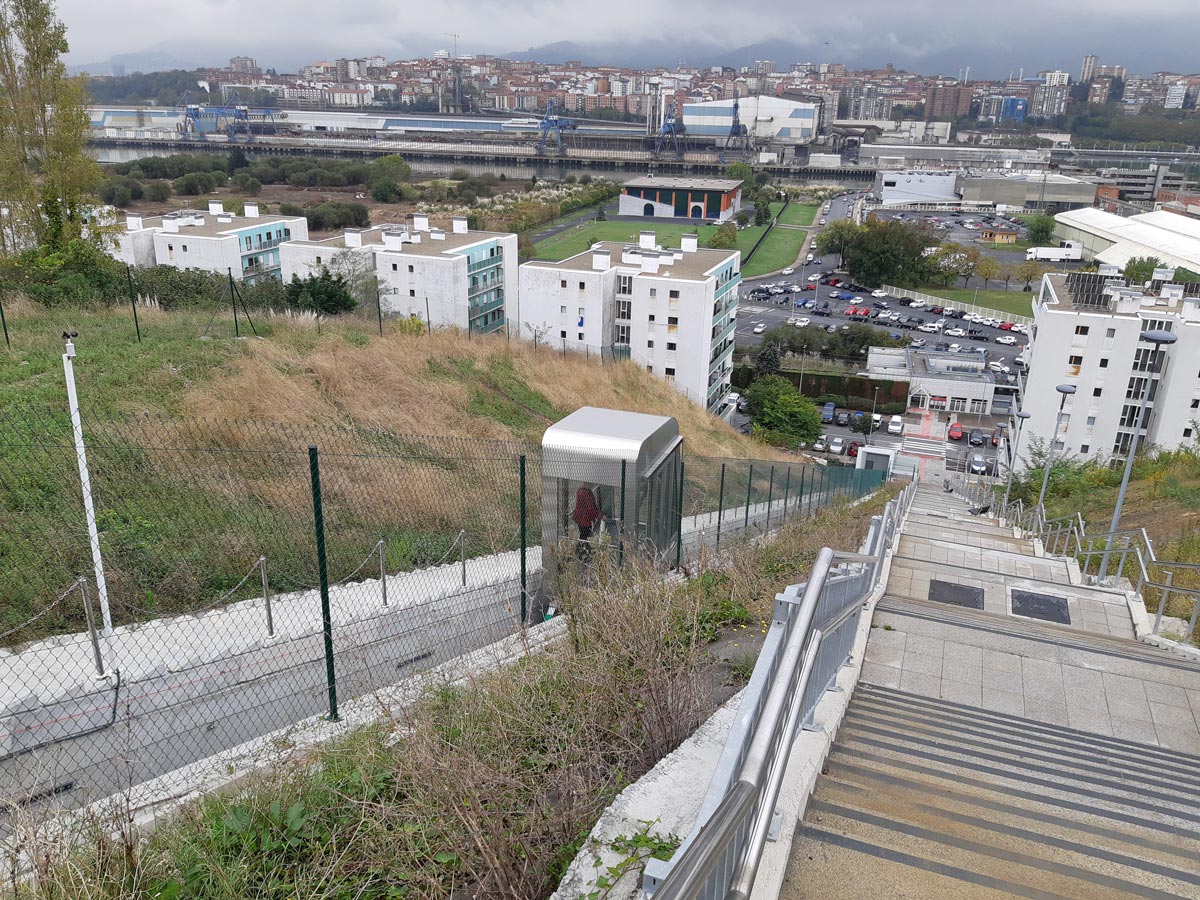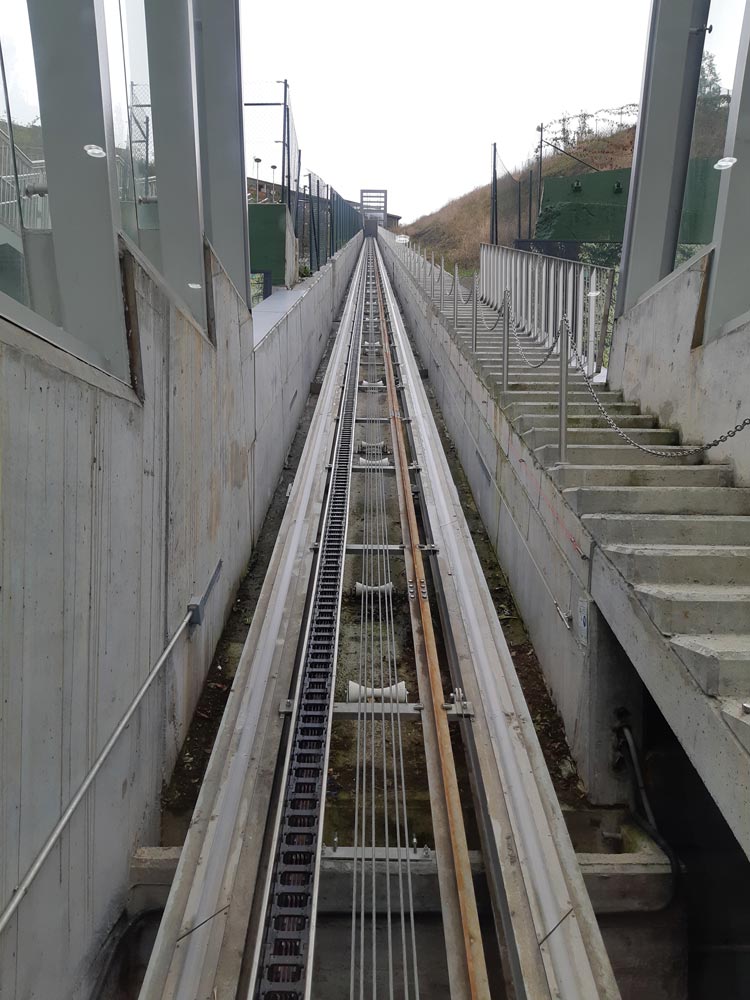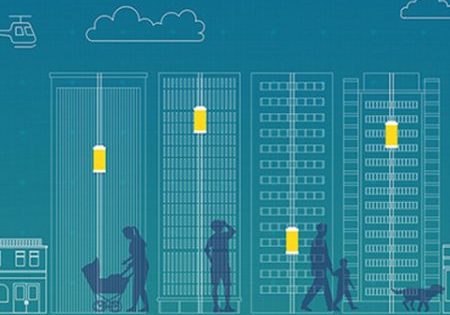Connecting People and Places
Feb 28, 2022

A new inclined elevator in Leioa, Spain, helps locals with access.
submitted by TKE
The Leioa Inclined Elevator Implementation Project was designed to link the 47-m gap between Langileria Street, opposite Lamiako Metro Station, and the Txorierri district in Biscaia, Spain. The singularities of the linked areas caused the project to take a different turn. The population density, together with the influence of the metro station, showed the relevance and, above all, the need to create an accessible route that would reduce use of private vehicles and increase the use of public transportation. This resulted in an environmental and communication improvement.
The roads used before the installation of the inclined elevator consisted of steeply sloping, staggered sections, typical of the mountain area and detours of considerable distance through nearby streets. These obstacles not only revealed the cumbersome task that passers-by had to deal with in order to reach their destination, but also the impossibility of access faced by a dependent or handicapped person.
The inclined elevator project not only connects places, but people. Also serving as a shelter from the weather, the installation in Leioa provides autonomy and freedom of transit to all its inhabitants. The inclined elevator, anticipating the traffic flow in the area and its proximity to the Lamiako Metro Station, has a capacity of 25 people and serves two stops. With a frequency of travel of up to eight round trips per hour, the elevator has the potential to carry 400 people in that stretch of time and is designed to provide passengers with a high level of comfort and safety. Facilitating the journey between distances in a comfortable space with air conditioning, the elevator is equipped with a mechanism for smooth and progressive acceleration and deceleration. These properties make the inclined elevator a stable and user-friendly installation for its occupants.
Consequently, the elevator not only meets demand at peak times, but also covers the daily transport accessibility needs of Leoia’s inhabitants.
Characteristics of the Installation
- Load: 1.875 kg
- 22° inclination
- Speed: 1.60 m/s
- Stops: 2
- Access: 1 (side)
- Rail length: 125 m straight route
- Panoramic cabin with 6+6 mm stadip securized glass and dimensions of 2,400 x 1,610 mm
- Traction gearless machine with control by means of frequency variator and energy regeneration system in descent
- Rescue by means of a ladder parallel to the trajectory
Design and Manufacture
TK Elevator (TKE) participated in the design of the elevator with the architect Santiago Pastor, general director of Vectia Ingeniería. For the general design of the installation, factors such as the orientation and the trajectory of the elevator were taken into account so that the elevator would not be strongly affected by the weather at its location in the North of Spain, which has a strong maritime influence, great rainfall and is open to the strong northwest winds that constantly sweep the Cantabrian coast. Therefore, implementing an anemometer to cancel the operation of the lift in case of the detection of dangerous storms or wind gusts guarantees the safety of the elevator. This mechanism halts the elevator, protecting the cabin in the lower stop.
The car was designed and manufactured by TKE, which produced “a robust design and elegant lines” adapted to all facilities (accesses, aediculae of stops, etc). TKE installed an air-conditioning system into the elevator frame to constantly maintain a comfortable temperature for elevator users on hot days, as well as in the harsh northern winter. Additionally, devices were integrated to promote a green and environmentally respectful environment. These include a gearless machine that does not use oil, illumination by low-energy consuming LEDs, a frequency variator to diminish power consumption for elevator starts and a system that generates energy when the elevator descends.
Assembly
The assembly of the inclined elevator required close coordination with the civil works department so that detailed planning and monitoring of the tasks of each of the guilds involved was carried out. Likewise, a complete safety study was executed to fully guarantee the working conditions not only of our installers, but all workers.
First, TKE proceeded with the layout of the work (pits, machine room, stops and awnings). After verifying that the dimensions were correct, the installation began by assembling the cabin and counterweight rail beams, as well as the associated devices such as cable ducts, cable guide rollers, etc. Then, the counterweight frame and the coining and side fastening guides were installed for safe transit onrails. The machine was then installed with its frame, and the electrical control panel, the doors, the frame with pulleys and the traction and coining cables were launched. Finally, the frame was introduced, and the cabin was installed with all the devices integrated inside the frame (air conditioning, coining system, etc.), as well as the electrical wiring for connection to the general panel accompanied by the cable chain. The process ended with the regulation of all the safety devices.
Credits
Leioa Town Hall, Biscay provided the property and acted as the promoter for the inclined elevator project. Pastor was the architect and Viconsa was the contractor. TKE was the manufacturer and oversaw assembly and maintenance.
Project Team
The project team consists of:
- Sales Manager and Key Account Manager: Joseba Ochoa is an industrial technical engineer from Mondragon University. He joined Ascensores Cenia, a subsidiary of TKE, as provincial delegate of Guipúzcoa in 1995, and later became national sales manager of the company. After the integration of both companies, he became national sales manager of new building elevators for ThyssenKrupp Elevadores España. Currently, he is the key account manager of Special Works (N.I.) in the North Zone of Spain.
- Project Manager: Carlos Trapiella is an industrial technical engineer from the University of Oviedo. He joined TKE in 2002, after having previously worked in quality management and inspection in different companies. During his years at TKE, he has carried out different functions in equipment design, specification study, elaboration of offers, leader of special projects and, in most recent years, as project manager in the department of project management and special assemblies. At TKE, he has been involved in subway projects (Bilbao, Madrid, Istanbul, New York, Cairo, etc.), airports (Barajas, Dubai, Barcelona, San Francisco, etc.) and urban accessibility (Leioa, Barcelona, Santa Coloma, Vitoria, Baracaldo, etc.).
- Person In Charge Of Assembly: Iosu Esteneaga Blanco, anengineer, with more than 13 years at TKE as head of assembly, has developed projects providing urban accessibility for the city councils of Bilbao and Gettxo, among others. Managing the assembly of vertical and inclined elevators, he has also participated as an assembly manager in expansion projects at Palacio Euskalduna and Bilbao airport (La Paloma).
- Design Manager: Raul Luengo Garciais an industrial engineer from the Polytechnic University of Madrid. He has been at TKE for more than 10 years, carrying out the mechanical design and calculation of a many steel structures and mechanisms for lift systems and stage equipment in theaters of Spain, Denmark, Poland, Dubai, Oman, Taiwan, etc. In addition, Leungo has experience in the design, calculation and monitoring of projects of inclined elevators installed in several towns in Spain.


Get more of Elevator World. Sign up for our free e-newsletter.









